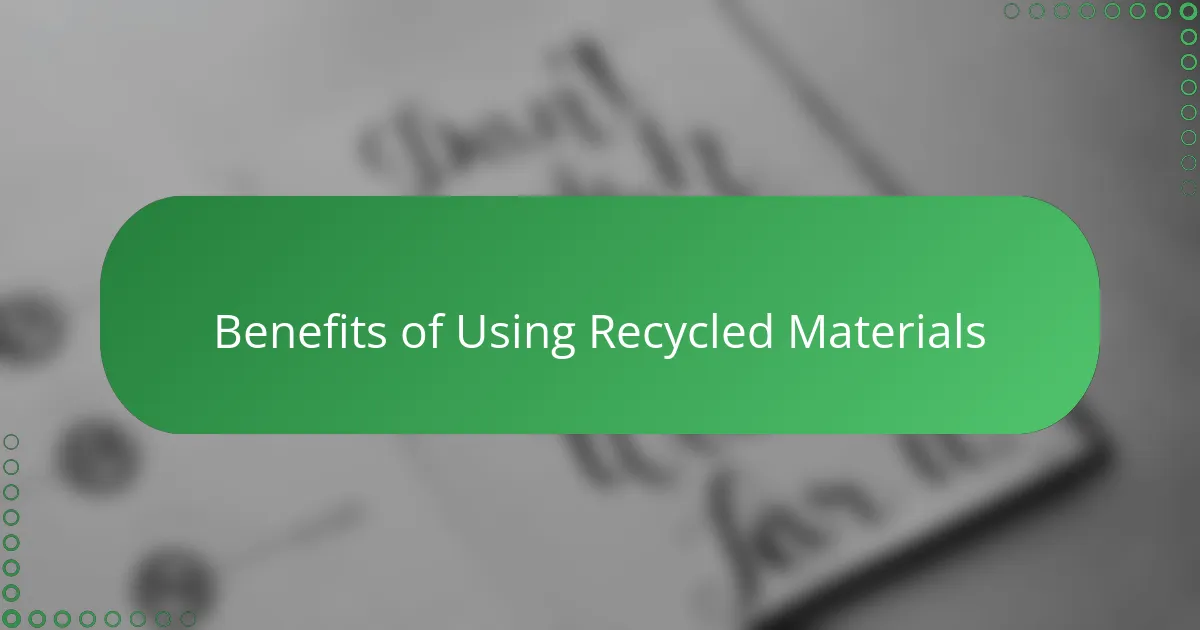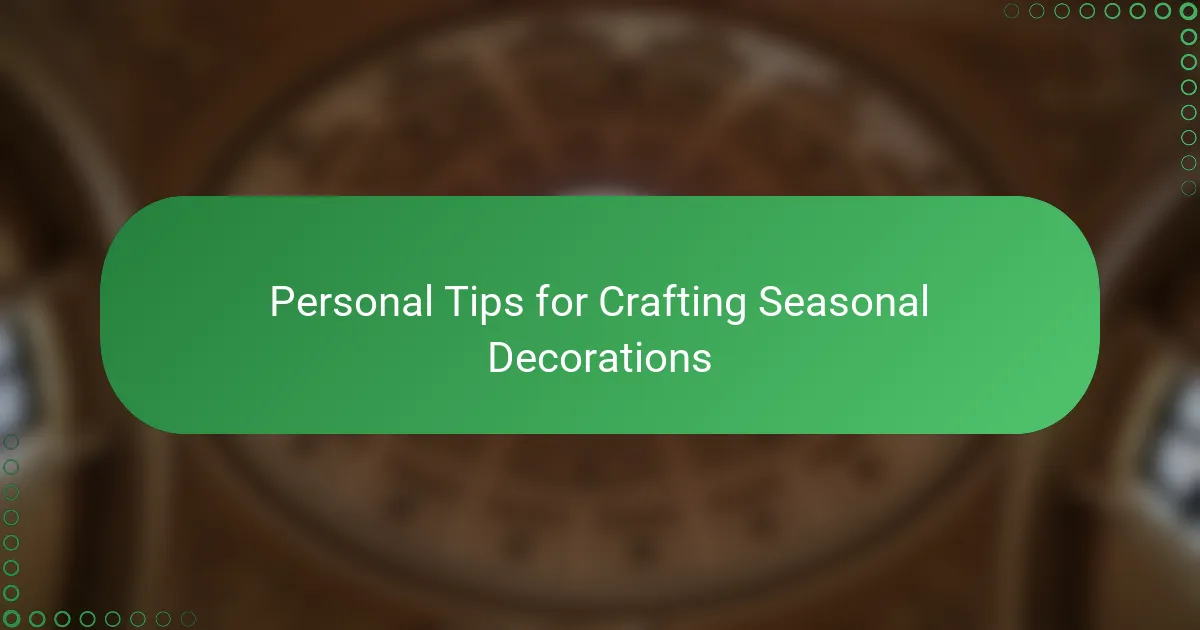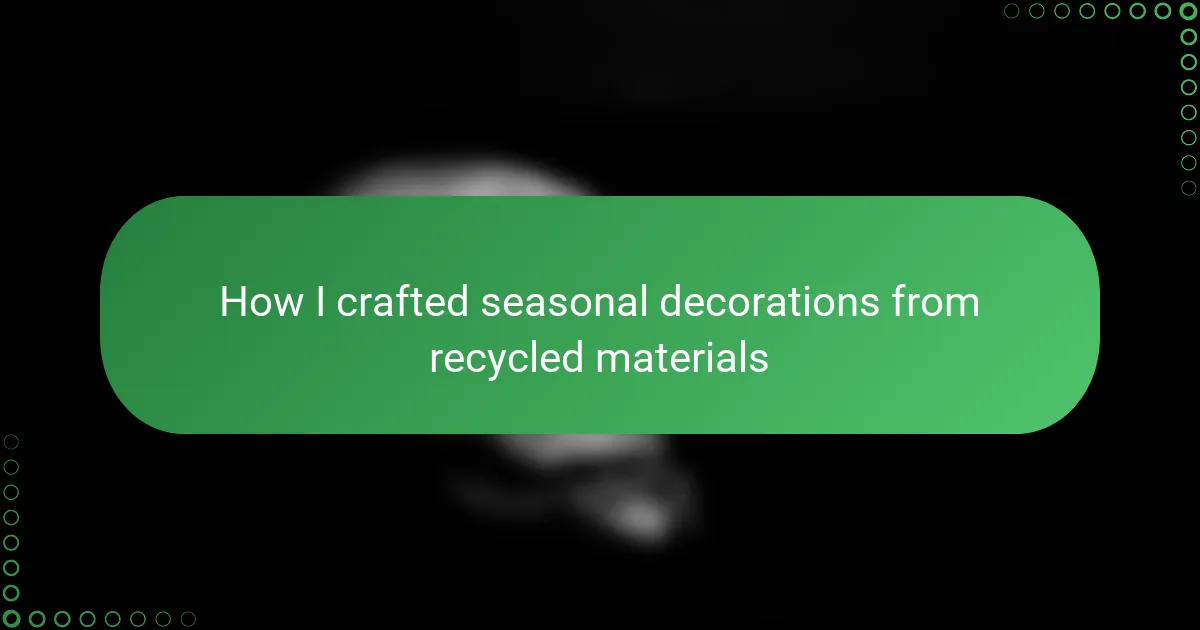Key takeaways
- Handmade paper crafts offer unique textures and a personal touch that machine-made paper lacks, emphasizing the connection to the crafting process.
- Using recycled materials not only reduces waste but also adds distinct patterns and colors to creations, making each piece uniquely beautiful.
- Choosing seasonal themes enhances the crafting experience and connection to nature, guiding material choices and design inspiration.
- Embracing imperfections and allowing for experimentation leads to more authentic and meaningful creations in handmade crafts.

Understanding Handmade Paper Crafts
Handmade paper crafts have always fascinated me because they bring such a unique texture and character that machine-made paper simply can’t replicate. Have you ever noticed how each sheet feels different, almost like it holds a story? That irregularity is what makes these crafts so charming and personal.
From my experience, working with handmade paper requires patience and an appreciation for imperfection. It’s not just about the final product; it’s about embracing the process—feeling the fibers as they blend and watching the paper come to life under your hands. This tactile connection creates a deeper bond with each craft.
What truly intrigues me is how versatile handmade paper can be. Whether you’re folding, cutting, or decorating, the possibilities seem endless. Have you found yourself inspired by the way recycled materials transform into something beautiful through this art? That sense of transformation is what fuels my passion for handmade paper crafts.

Benefits of Using Recycled Materials
Using recycled materials in handmade paper crafts has always felt like a meaningful way to give new life to what would otherwise be discarded. I remember feeling a real sense of satisfaction knowing that the scraps and remnants I gathered weren’t just trash but valuable resources waiting to be transformed. Doesn’t it feel rewarding when you realize your craft is helping to reduce waste while creating something beautiful?
Another benefit I’ve found is the unique texture and character recycled fibers bring to each piece. Because these materials come from varied sources, they add unexpected patterns and colors, making every decoration distinct. Have you ever noticed how recycled paper seems to tell a story through its imperfections and hints of its past life? That unpredictability adds a charming depth I rarely get from fresh materials.
Lastly, working with recycled materials often means I’m saving money without sacrificing creativity. From my experience, this financial advantage lets me experiment more freely and take creative risks I might avoid otherwise. Isn’t it amazing how sustainability and economy can go hand in hand in crafting? This balance encourages me to keep exploring new ideas with recycled scraps every season.

Choosing Seasonal Themes for Decorations
Choosing seasonal themes for decorations has always been an exciting part of my creative process. I like to think about what the season feels like—whether it’s the crispness of autumn air or the fresh bloom of spring—and let those emotions guide my choices. Have you ever noticed how certain colors or motifs instantly evoke a memory or mood tied to a specific time of year?
Sometimes, I find that the best themes emerge from simple observations of nature around me. Collecting fallen leaves, pinecones, or even seed pods not only inspires the design but also helps me connect more deeply with the season. Do you ever find that these natural elements tell a story that you want to share through your decorations?
What I’ve learned is that focusing on a seasonal theme adds purpose and cohesion to the whole craft. It’s easier to choose recycled materials when I have a clear vision—like aiming for warm tones in autumn or cool pastels in winter. This intentional approach turns crafting into a meditation on the season itself. Have you tried letting the season lead your creative choices? It might just change how you see your materials.

Selecting and Preparing Recycled Paper
Selecting the right recycled paper has always been my first and most crucial step. I tend to look for paper that’s not too brittle or glossy because those qualities can make crafting a challenge. Have you ever tried using paper that just wouldn’t hold together? It’s frustrating, and I’ve learned to avoid that by testing scraps first before committing.
Preparing recycled paper feels like a delicate ritual to me. I soak the paper pieces in warm water, allowing the fibers to soften and loosen, which makes the blending process smoother. I find that this simple step not only helps create a better pulp but also gives me a moment to pause and appreciate where the paper has been before it’s reborn in my decoration.
Sometimes, I add a bit of natural dye or fiber from other recycled materials during preparation, just to enhance the texture or color subtly. It’s like mixing memories into the mix. Have you ever played with combining different scraps, knowing it will make each piece uniquely yours? That element of surprise is one of my favorite parts of crafting with recycled paper.

Step-by-Step Crafting Process
When I begin crafting seasonal decorations from recycled materials, I always start by gathering and sorting my paper pulp carefully. Have you ever noticed how selecting the right pieces sets the tone for the entire project? It’s almost like choosing the ingredients before cooking a meal—you need quality and compatibility to create something satisfying.
Next, I move into the blending and molding phase, where patience becomes key. Sometimes, it feels like the fibers have a mind of their own, refusing to mesh perfectly at first. But I’ve learned that embracing this unpredictability makes the final piece feel more authentic and alive—like it carries a little story within its texture. Don’t you think that’s part of the magic?
Finally, shaping and drying the decorations requires steady hands and a bit of timing. I’ve found that placing the wet paper into simple molds or letting it dry naturally on textured surfaces adds an extra layer of charm. Have you ever experimented with letting nature influence the shape and feel of your crafts? It’s a small act but one that deepens the connection between my work and the season I’m celebrating.

Personal Tips for Crafting Seasonal Decorations
Working on seasonal decorations from recycled materials, I’ve found that setting aside dedicated time really makes a difference. When I’m not rushed, I can focus on the little details—the way a particular fiber blends or how a color shifts as it dries. Have you ever noticed how slowing down enhances your connection to the craft? For me, this mindfulness brings a kind of calm that I treasure.
I also recommend embracing imperfections wholeheartedly. Early on, I struggled with letting go of “flaws,” but now I see them as part of the story each decoration tells. Those tiny wrinkles, uneven edges, or unexpected color spots give my creations personality. Doesn’t it feel more special when your decoration feels uniquely alive, rather than perfect?
Finally, don’t be afraid to experiment with combining materials you wouldn’t usually think go together. I once added bits of dried herbs into my paper pulp, and the subtle texture and scent surprised even me. How often do you take creative risks in your crafting? From my experience, those little adventures often lead to the most memorable and meaningful results.

Displaying and Maintaining Your Creations
Displaying your handmade paper decorations is where the magic truly comes alive. I’ve found that choosing spots with gentle lighting not only highlights the textures but also prevents the delicate recycled fibers from fading or becoming brittle. Have you ever noticed how a well-placed decoration can transform a room’s atmosphere and invite a touch of warmth?
Maintaining these creations takes a bit of care, but it’s surprisingly simple. I make it a habit to dust them softly with a dry, clean brush—like whispering a gentle hello to my work—because moisture or heavy cleaning can damage the fibers. Does the thought of preserving your art for seasons to come motivate you to treat it with extra kindness?
Over time, I’ve learned that storing your decorations in acid-free tissue paper or a breathable box helps maintain their integrity, especially when the seasons change. It’s like giving them a cozy little home, ready for their next debut. Have you ever prepared your crafts for hibernation, looking forward to their next moment in the spotlight?
